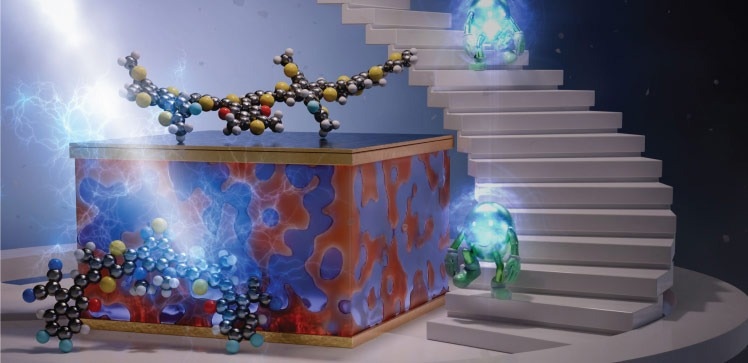Reviewed by Mila PereraSep 14 2022
Researchers from King Abdullah University of Science and Technology (KAUST) have illustrated how an electronic mismatch in the pairs of materials to create organic solar cells can be employed to improve cell operation.
 Illustration showing how incoming solar light excites electrons into different energy levels, which generates voltage. Image Credit: Reproduced under creative commons license from Bertrandie et al. (2022); Original artwork by Hassan Tahini
Illustration showing how incoming solar light excites electrons into different energy levels, which generates voltage. Image Credit: Reproduced under creative commons license from Bertrandie et al. (2022); Original artwork by Hassan Tahini
The striking finding — made after a detailed reanalysis of advanced organic solar materials — should allow scientists to estimate new organic formulations with robust solar cell performance.
The light-trapping layer of organic solar cells usually comprises a two-component blend known as a donor-acceptor blend.
In sunlight, the inbound energy can stimulate electrons to jump between various energy levels in the blend, signifying that the energy level alignment between the donor and the acceptor component should be paramount to the performance of a device. However, numerous research groups have used various approaches to assess energy levels and have generated contradictory outcomes on the impact of energy level alignment.
We wanted to understand the origin of this contradictory understanding. This motivated us to study the energy levels of organic solar cell materials using different methods to establish meaningful material–property relationships.
Anirudh Sharma, Study Lead and Postdoctoral Researcher, Derya Baran Lab, KAUST
The researchers established the energy levels of 33 organic solar materials by applying four different methods.
Our findings show that the energy levels of organic semiconductors measured using photoelectron and low-energy inverse photoelectron spectroscopy closely correlate to the properties of solar cells.
Jules Bertrandie, Ph.D. Student, Derya Baran Group, KAUST
In comparison, he observes that cyclic voltammetry delivered deceptive results concerning solar cell energy levels.
After determining the ideal approaches for the measurement, the researchers examined energy level alignment in 12 donor-acceptor organic solar cell blends. The results revealed — contradictory to current belief — that blends with negligible difference in one energy level metric, referred to as the ionization energy, were weak performers. The ideal-performing organic solar cells revealed a significant difference in ionization energy between the donor and the acceptor component in the blend.
We were not surprised that our proposal for a new type of energy level measurement would be more reliable, but we were surprised that our hypothesis revealed that what is commonly believed in literature is actually not true. This method has huge potential to reveal new donor–acceptor pair systems that could work well in organic solar cells and would also highlight which pairs won’t work.
Derya Baran, Associate Professor, KAUST
Sharma states, “The implications of this study are relevant for a larger field of organic electronics in general.”
Journal Reference
Bertrandie, J., et al. (2022) The Energy Level Conundrum of Organic Semiconductors in Solar Cells. Advanced Materials. doi.org/10.1002/adma.202202575.